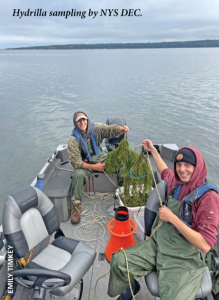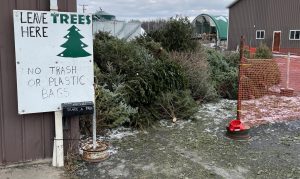By Liz Kreitinger, Steward/Executive Director, Cayuga Lake Watershed Network
In 2024, the NYS DEC, US Army Corps of Engineers, Finger Lakes Partnership for Regional Invasive Species Management (PRISM), and local Hydrilla Task Force Partners continued their coordinated hydrilla management in Cayuga Lake. Hydrilla is considered a high risk aquatic invasive species and is notoriously challenging to eradicate. Local, state, and federal invasive species managers have evaluated, monitored, and supported this hydrilla program for over a decade. This year, their work included:
The NYS DEC Region 7 Aquatic Invasive Species Coordinator and field staff monitored hydrilla at 12 locations from May to October. Data from 6,230 points across 1,000 surface acres showed hydrilla only near known infestation sites: Aurora, Sheldrake, Weyers Point, Ladoga Bay, Lansing Harbor, and Myers Park Marina. The Coordinator oversaw herbicide treatments in Aurora, Sheldrake, Myers Park, Lansing Harbor, and Ladoga Bay, while staff worked with USACE, USFWS, and FL PRISM on large-scale monitoring in Aurora and the lake’s southern area.
The US Army Corps of Engineers Buffalo District continued herbicide treatments in the Aurora infestation area (99 acres) and Ithaca (51 acres). Surveys in the Aurora treatment area showed 1.3% detection of hydrilla, suggesting effective control overall, except in the area offshore of MacKenzie-Childs. Ithaca surveys showed hydrilla in 0.5% of samples. Both areas showed good presence of other aquatic plants. The areas near MacKenzie-Childs, Fall Creek, and portions of the Cayuga Lake inlet remain as areas of concern for management in the south end.
The Finger Lakes PRISM completed over 3,600 rake toss surveys in Cayuga, finding no new hydrilla populations. However, hydrilla was observed growing in the Myers Park Marina in September. Don’s Marina in King Ferry, last treated in 2019, showed no hydrilla for the fifth consecutive year—a promising sign of effective management.
Public transparency is a key part of the Cayuga Lake Hydrilla program. For years, the Hydrilla Task Force has issued pre- and post-treatment press releases and held public meetings. The Cayuga Lake Watershed Network leads information sharing and public engagement by providing updates at lakeshore locations, through newsletters and the website, and by hosting an end-of-season public forum. These efforts allow the community to ask questions, voice concerns, and learn about the management plan and results from the agencies.
This year’s public meeting was held on December 4th and included important questions that have been brought up by the community, including about the chemistry of the herbicides used, long-term impacts of hydrilla and its treatment, and the future of the program given reductions in Great Lakes Restoration Initiative funding to the USACE for the program. A recording of the meeting is available on CLWN’s YouTube Channel and the presentation pdfs can be found on our Hydrilla Information and Action webpage.


